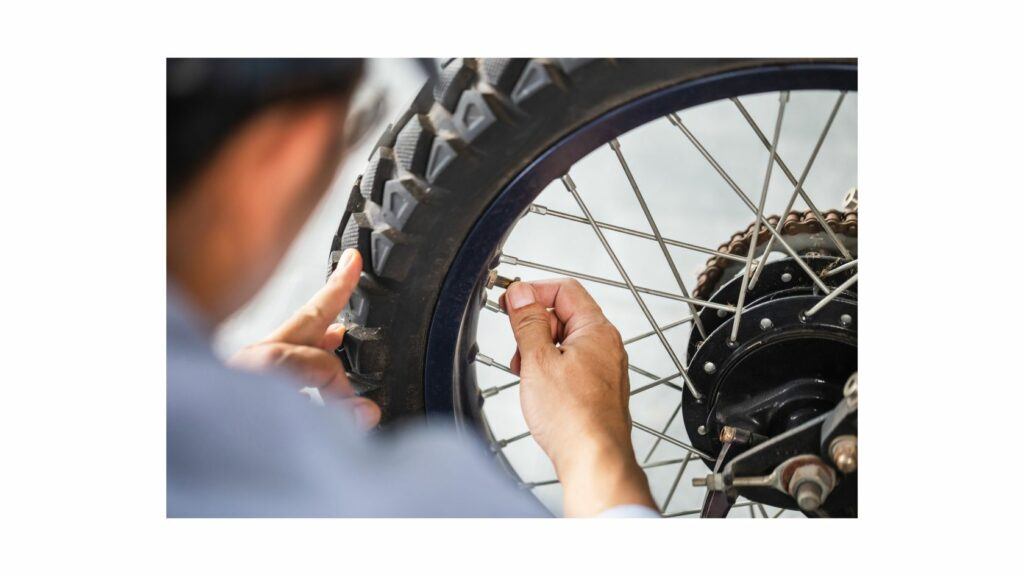
Do you feel vibrations when riding your motorcycle? Is your motorcycle wandering or drifting at one end frequently? These are confirmed signs to get your motorcycle tires balanced. You must be wondering – do motorcycle tires get balanced?
Wheel balancing may seem or sound alien to motorcycle riders. The symptoms mentioned above are often mistaken for the bad condition of roads, unbalanced air pressure in tires, etc. and many times ignored by the bike owners.
So, do you really need to get your motorcycle tires balanced? If yes, is it both tires or only one tire that needs balancing? Can the balancing process be performed by anyone?
Find the answers to these questions and much more related to motorcycle tire balancing in this post.
Do motorcycle tires get balanced?
The simple answer is YES. Motorcycle tires do get balanced and should be balanced whenever you feel abnormalities in the riding performance.
The balancing of tires can be performed using different methods. The most common being the static balance and dynamic balance methods. Both these methods are used by the tire repairing stations/services on specialized machines.
Some of the other methods to identify the unbalancing of wheels are using the jacks, or a vertical stand.
Whichever method you use, make sure the process is performed accurately to avoid leaving loose ends on unbalancing as well as refixing the tires to the motorcycle.
Out-of-balance motorcycle tire symptoms
While the symptoms may vary according to the condition and environment a motorcycle is ridden on, one of the common signs is constant vibrations. This can be felt in the handlebars, seats, foot pegs, and even mirrors that increase with speed.
Some of the other causes include drifting of the motorcycle to one end, finding the steering stiffer than usual, signs of uneven wearing especially on one tire, and increased fuel consumption.
If you sense any of the above symptoms while riding, it is important to pay special attention to tires and initiate a balancing process for a smoother ride and improved tire life.
What causes unbalancing of tires on a motorcycle?
There are several factors that add to the unbalancing of tires. Here are a few of them:
Uneven wear – Tires are prone to wear with time. Proper maintenance and periodic replacement are the best solutions to counter the wearing.
However, if you continue using worn-out tires without servicing or maintenance for a long time, they are bound to catch uneven wear.
The conditions of the road also play a culprit in giving uneven wear especially when the bike hits deep potholes or pavements, or mostly run on bad roads.
Improper tire pressure – If you think improper tire pressure only leads to punctures or tire blowouts then think again.

If the tire has low pressure, it automatically build-up heat to the internal parts of the tires causing reduced friction with the road. As a result, rotating parts of the wheels are under tremendous pressure to maintain traction.
In such instances, motorcycles can go out of control which may lead to unbalancing of wheels.
Incorrect wheel alignment – The wheel alignment process is different than wheel balancing. Here, the alignment process is performed to check the contact of the wheels with the surface.
Wheel alignment involves correcting the direction, angle, and position of tires so that tires are capable of transferring the weight appropriately.
On the flip side, if the wheel alignment process is performed casually or incorrectly it will impact the weight distribution causing the tires to lose balance.
Related Read: Why are motorcycle tire treads opposite?
Unbalanced weight distribution – The purpose of balancing the wheels is to allow the motorcycle to distribute the weight equally.
When you keep running the motorcycle for a long time on the same set of tires without performing wheel balancing it may cause a shifting of weight on one tire leaving the other unbalanced.
All these factors not only affect the condition of tires but also impact the performance of suspension, steering, and rotating parts that are responsible for tire unbalancing.
How to balance motorcycle tires?
As mentioned above, there are two conventional ways to balance motorcycle tires:
Static balance–Static balance is one of the easiest, cheapest, and most effective ways to balance the tires. The process involves a static balancer, some small weights, a tire, and a wheel rim.
To perform the process you need to put the whole tire and rim on the static balancer with the help of the spindle tool. Once installed, the wheel will start to move and the heavier side will stop in the lower direction.
This means you have to put some weights on the opposite side (upper portion) to balance the rotation. Once the appropriate weight is placed the wheel will remain static which means the balancing is achieved.
Static balancing is an ideal method to balance the tire with small to moderate levels of imbalances.

Dynamic balance–Dynamic balance is more of an automated process compared to static balance and is geared to cover the high levels of im-balancing scenarios.
Under the dynamic balancing method, a fully assembled wheel and tire are placed on a spinning machine that is connected to a computer screen.
The spinner rotates the tire from lower to higher speeds and measures the weight of the tire. It then detects the uneven weight portions on the screen with its sensors.
On completion of the process, the machine highlights the sections of the tire that need to be balanced with additional weights.
How to balance motorcycle tires without a machine?
Balancing tires without a machine is a tricky process but still possible. Many motorcyclists who are used to playing with hard metals and tools do the balancing on their own.
One of the best ways to do it is by using a balancing stand. If you don’t have any specific stand, you can also use metal jacks or any other structure that acts like a stand to spin the wheel.
Remember, the structure should be strong enough to handle the weight of a wheel and convenient to spin the wheel.
Place the tire on the balancing stand or between the two jacks/structures and rotate it to find the sections with uneven balance.
Next, put the weight on these sections and place it again on the stand to check the achievement of balance.
If the wheel remains unmoved your job is done!
How to balance a motorcycle tire with beads?
Using beads is another easier way to balance the tires. To use beads, first follow the balancing process of placing the wheel on a stand.
Next, remove the valve stem and other screws as the beads need to be put inside of the tire.
Use a bottle pipe to fill the tire with beads. Begin with a lesser number of beads and gradually insert more beads to achieve proper weight.
The highlight of balancing beads is they measure the difference in weight while the motorcycle is in motion and simultaneously spread themselves to the sections lacking weight.
Sports bikes, racing motorists, and riders who ride their motorcycles at higher speeds (more than 200km/H) will not benefit from using balancing beads. So, if you are one of them adopt the conventional balancing methods.
Here is a small video covering motorcycle tire balancing using the static balance method/beads:
What size of weights should be used to balance the motorcycle tires?
Generally, wheel weights come in 5g to 10g (0.18 oz to 0.35 oz). Adhesive wheel weights are ideal to perform the balancing. You can easily stick them to the affected section without any effort.
You can also use non-adhesive wheel weights which are more effective than adhesive ones but come at a higher cost.
How often balancing of motorcycle tires should be performed?
Tire balancing should be performed whenever you feel vibrations, bumpiness, and drifting while riding.
Tire experts recommend seeking wheel balancing as part of routine maintenance or every 5000-10000 km.
Should balancing be performed on both motorcycle tires?
Motorcycle servicing experts claim that a front tire is more prone to unbalancing than a rear tire.
The front tire is vital to execute braking, and cornering which keeps the suspension under constant weight shifts. This is the reason you must pay special attention to your motorcycle’s front tire.
Having said that, there is nothing wrong with balancing both tires.
How much does a standard balancer cost?
A factory-made balancer does not cost more than $100 which is ideal to perform tire balancing under the static method.
Does the motorcycle need an alignment?
Yes, motorcycles need alignment as part of their maintenance and also whenever the need arises.
Performing wheel alignment on a timely basis helps your motorcycle maintain proper suspension.
The alignment process is also instrumental in keeping the angles parallel so that tires maintain proper contact with the ground.
Lack of wheel alignment could impact and damage the suspension, rotation, and traction of a motorcycle which may lead to serious consequences.
Final thoughts
Tire balancing is a necessary process that should be performed periodically to keep the suspension and rotation elements of wheels healthy,
Make use of the professionally-design balancing stands to perform balancing.
If you have more time and looking to save some money you can do the balancing in your garage using some balancing structures like jacks/metal rods. Static balancing is easy to do and bodes well with tires that are slightly unbalanced.
For complex cases of uneven tires, a dynamic balancing process is recommended that should be performed under the guidance of experts.
Keep the tires properly inflated and avoid speeding on demanding roads to maintain the balance for a longer time.
Once you notice the causes of unbalancing mentioned in this post get the tire balanced asap for an improved and smoother ride.

